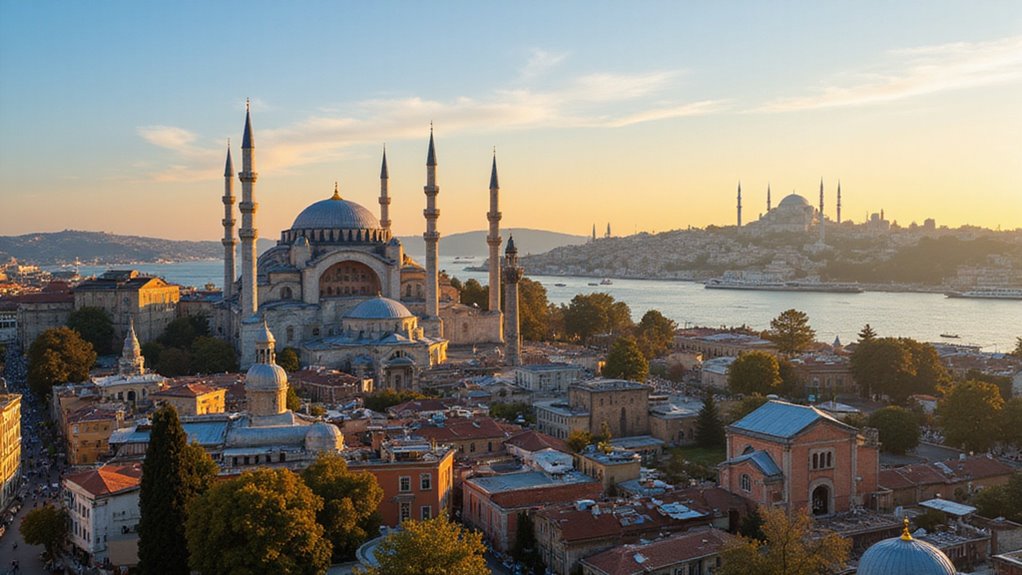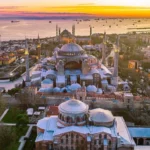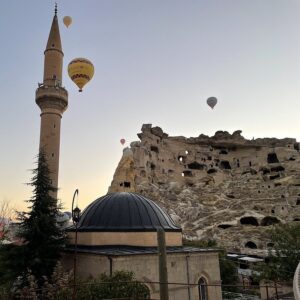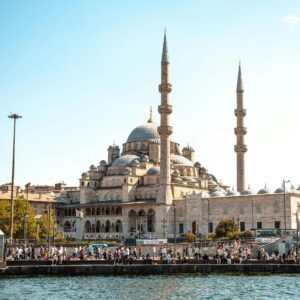Embark on an unforgettable Istanbul tour and discover the city’s most iconic landmarks. Marvel at the majestic Hagia Sophia, explore the opulent Topkapi Palace, and admire the stunning Blue Mosque. Wander through the vibrant Grand Bazaar before enjoying a scenic Bosphorus cruise. This perfect introduction to Istanbul blends history, culture, and breathtaking views into one extraordinary experience.
Key Takeaways
- Hagia Sophia: Iconic Byzantine architecture with a 55.6-meter dome, marble floors, and historical transformations.
- Topkapi Palace: Ottoman opulence with four courtyards, İznik tiles, and the Imperial Harem.
- Blue Mosque: Islamic masterpiece with six minarets, a 43-meter dome, and 20,000 blue İznik tiles.
- Grand Bazaar: One of the world’s largest covered markets with 4,000 shops and historic domed ceilings.
- Bosphorus Cruise: Scenic journey showcasing Europe and Asia, passing landmarks like Dolmabahçe Palace and Maiden’s Tower.
Hagia Sophia
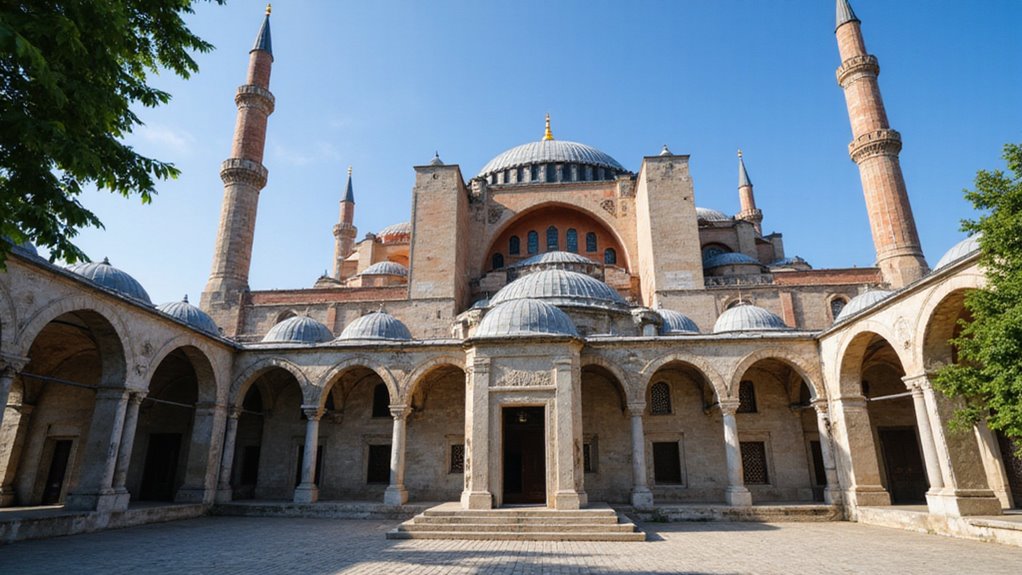
One of Istanbul’s most iconic landmarks, Hagia Sophia, is a must-see for any traveler exploring this historic city.
You’ll marvel at its Byzantine Architecture, with its massive dome and intricate details that changed architectural history. Built in 537 A.D., the Hagia Sophia’s central dome, soaring 55.6 meters high, dominates the skyline. Constructed using materials from across the Byzantine Empire, including Anatolia and North Africa, it stands as a testament to ancient craftsmanship.
Step inside to admire its marble floors, columns imported from ancient temples, and the Omphalion, where emperors were crowned. You’ll witness the Historical Transformations that shaped this monument, from a Byzantine church to an Ottoman mosque and now a dual-purpose site. For a deeper understanding of Ottoman heritage, consider exploring the Beylerbeyi Palace, a 19th-century architectural gem on the Asian side.
Explore its upper floor museum, featuring preserved mosaics alongside Islamic calligraphy. Plan your visit between 9:00 a.m. and 7:30 p.m., avoiding prayer times, and dress modestly.
With an entrance fee of €25, you’ll uncover the layers of history that make Hagia Sophia an unforgettable experience. While entrance to Hagia Sophia is optional on the Full Day Historical Old City Tour, it’s highly recommended to fully appreciate this architectural marvel.
Topkapi Palace
After marveling at the grandeur of Hagia Sophia, make your way to the nearby Topkapi Palace, a sprawling symbol of Ottoman opulence and power.
This UNESCO World Heritage Site, built in the 15th century, served as the sultans’ residence for nearly 400 years. Wander through its four majestic courtyards, each reflecting the empire’s hierarchical structure, and admire its blend of Ottoman, Islamic, and European architectural features.
The intricate İznik tiles, detailed ornamentation, and ingenious spatial organization will leave you in awe. Don’t miss the Imperial Harem, a secluded labyrinth of over 400 rooms that once housed the sultan’s family and concubines.
Intricate İznik tiles and ornate details captivate, while the Imperial Harem’s 400-room labyrinth reveals Ottoman grandeur.
Step into the Privy Room of Murad III, adorned with stunning tiles and calligraphy, to glimpse the opulence of royal life. Topkapi Palace is a representation of history, art, and power, offering a journey through time you won’t forget. Its proximity to other iconic landmarks like the Blue Mosque and Grand Bazaar makes it a convenient stop on any Istanbul tour. For a deeper dive into Istanbul’s history, consider joining a full-day historical tour that includes this magnificent palace.
Blue Mosque
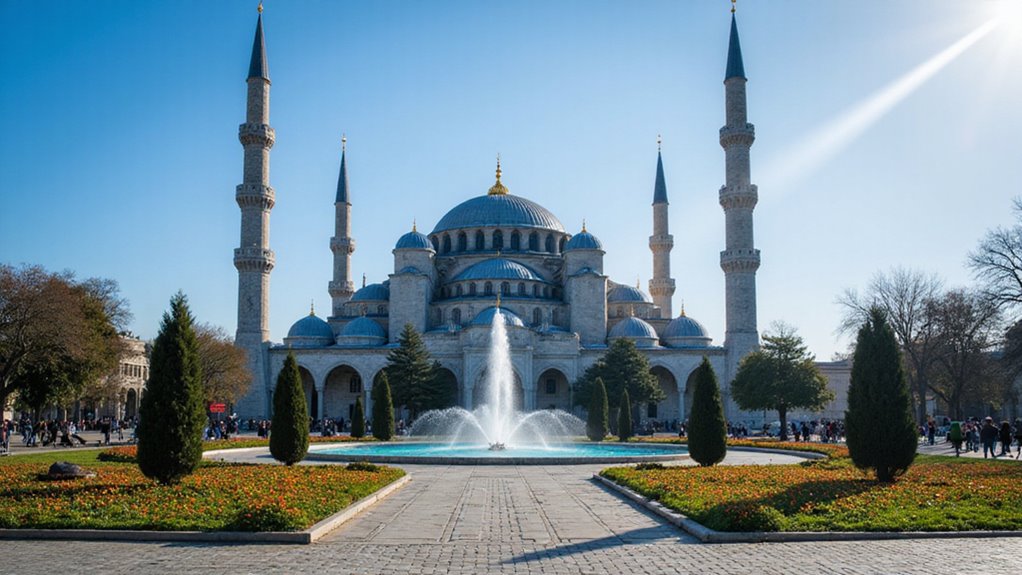
Though located just a short walk from Hagia Sophia and Topkapi Palace, the Blue Mosque, or Sultan Ahmed Mosque, stands as a breathtaking masterpiece of Islamic architecture.
Its history significance dates back to the early 17th century, built by Sultan Ahmed I to restore Ottoman glory after a less favorable treaty. Designed by Sedefkâr Mehmed Ağa, it combines traditional Islamic styles with Byzantine influences, creating a structure that rivals Hagia Sophia in grandeur. For those interested in more architectural marvels, consider exploring the Süleymaniye Mosque, another iconic structure in Istanbul.
The mosque’s architectural features include six striking minarets, a massive 43-meter-high dome, and over 20,000 blue İznik tiles that give it its nickname. To avoid confusion with other similar landmarks, Wikipedia provides a disambiguation page that directs users to the correct article.
Step inside to admire the intricate floral patterns, towering marble pillars, and exquisite calligraphy. The mosque remains an active place of worship, so check visiting hours to avoid prayer times. For a stress-free alternative to public transport, consider booking a shuttle transfer to ensure a comfortable journey to this iconic site.
Dress modestly, covering shoulders and knees, and bring a scarf for your head. Entry is free, but donations are appreciated.
Don’t miss this iconic symbol of Istanbul’s rich heritage.
Grand Bazaar
The Grand Bazaar, just a short distance from the Blue Mosque, is a must-visit destination that immerses you in Istanbul’s vibrant history and culture.
This sprawling market, one of the largest and oldest covered bazaars in the world, offers an unforgettable shopping experience. Wander through its labyrinthine alleys, where over 4,000 shops sell everything from handcrafted jewelry and Turkish carpets to spices and ceramics.
The bazaar’s cultural significance is evident in its historic architecture, featuring domed ceilings, vaulted passageways, and ornate facades. Don’t miss the Cevahir Bedesten, where valuable antiques and treasures are displayed. The Grand Bazaar in Istanbul, Turkey has been a hub of trade and culture for centuries, reflecting the city’s rich heritage. After exploring the bazaar, consider taking a Bosphorus Cruise to experience the city’s iconic skyline from the water.
Bargaining is part of the fun, so embrace the tradition as you explore. With no entrance fee, you’re free to soak in the lively atmosphere, visit cafes, and admire the intricate craftsmanship. The Grand Bazaar is also conveniently located near other historical sites like the Hagia Sophia and the Blue Mosque, making it a perfect addition to your Istanbul itinerary.
The Grand Bazaar isn’t just a market—it’s a journey through centuries of trade, culture, and connection.
Bosphorus Cruise

A Bosphorus Cruise is an unforgettable way to experience Istanbul’s unique charm, where Europe and Asia meet along a stunning waterway.
You’ll glide past palaces like Dolmabahçe and Çırağan, mosques such as Ortaköy and the Blue Mosque, and iconic landmarks like the Maiden’s Tower and Rumeli Fortress. The Bosphorus Strait, formed around 7,600 years ago, offers breathtaking views showcasing a mix of ancient history and modern cityscapes. Multilingual audio guides enhance the experience by providing insightful commentary in various languages.
Cruise options cater to every taste—sightseeing tours with audio guides, romantic sunset cruises, or lively dinner cruises with Turkish folk dances and DJs.
Boarding is easy at piers like Kabataş and Eminönü, with timings from morning to night. Spring and autumn are ideal for calm waters and vibrant skies.
Whether you choose a public ferry or a private yacht, this journey offers freedom and a fresh perspective on Istanbul’s beauty.
Don’t miss this essential experience!
Frequently Asked Questions
What’S the Best Time to Visit Istanbul?
Your best bet for visiting Istanbul’s seasons is spring (April-May) or autumn (September-November). These ideal months offer mild weather, fewer crowds, and vibrant events like the Tulip Festival, giving you the freedom to explore comfortably.
Are There Any Dress Code Restrictions for Tourists?
Wondering if you’ll face strict dress codes? There aren’t official rules, but cultural sensitivity matters. Dress modestly in mosques and conservative areas; elsewhere, you’re free to wear Western attire. Avoid revealing clothes in religious sites or rural spots.
How Do I Navigate Istanbul’S Public Transportation?
You’ll find Istanbul transport easy to navigate with its tram system, metro routes, and ferry services. Use apps like Moovit or Google Maps for real-time updates, and avoid peak hours for a smoother journey.
Are Credit Cards Widely Accepted in Istanbul?
You’ll find credit card usage common in Istanbul, with Visa, Mastercard, and contactless payments widely accepted at hotels, restaurants, and larger stores. However, carry cash for smaller purchases, markets, and local vendors for more payment options.
What Local Dishes Should I Try in Istanbul?
You’ll crave Istanbul’s flavors like simit, balık ekmek, and midye dolma. Don’t miss traditional meals such as döner kebab or lahmacun. End with baklava or künefe for dessert—your taste buds will be set free.


